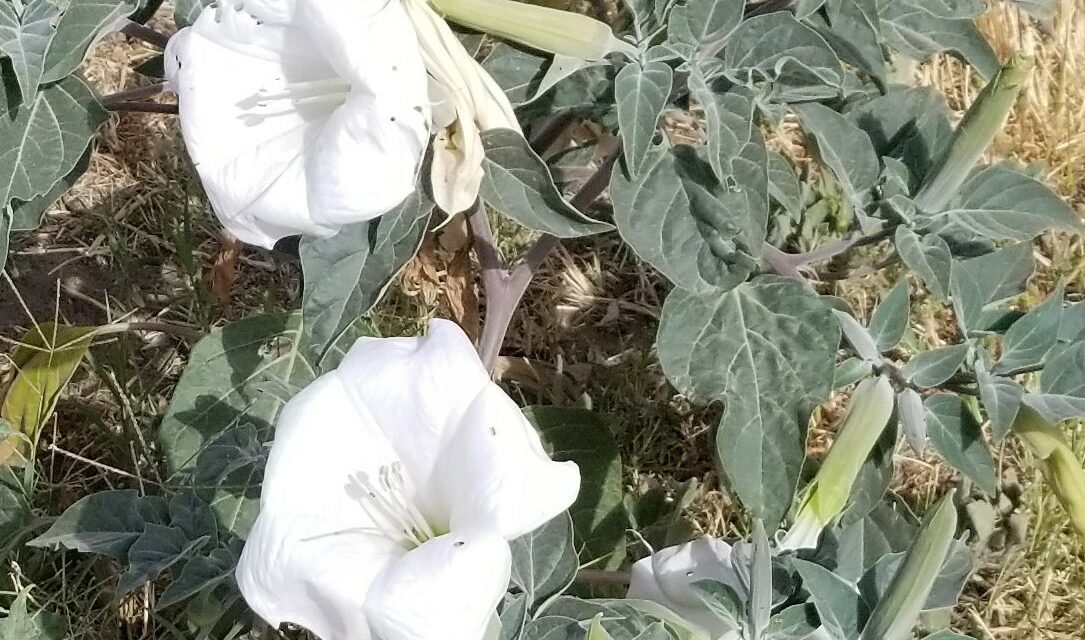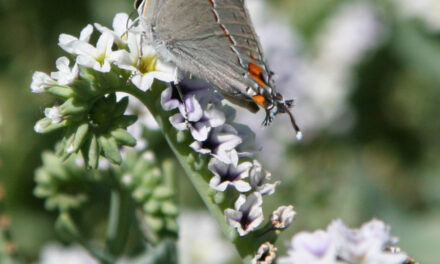It’s a common flower seen alongside the road or trail, or in the middle of a grassland especially early in the morning or as the summer sun is going down. Its big, white, trumpet-shaped blossom has a sweet scent and it’s a key part of the life cycle of the hawk moth, an insect with a 14-inch “tongue.”
Datura (Datura wrightii) is a California native and along with its close cousin (Datura stramonium) goes by many aliases: Poison datura, sacred thorn apple, devil’s trumpet, Toluaca and most famously, Jimsonweed.
The origin of the more renown sobriquet has a remarkable place in American history, early American history, as far back as Virginia Colony’s Jamestown in 1675 as Bacon’s Rebellion frustrated the Crown’s colonial governor.
The first, but certainly not the last popular uprising objecting having a king in charge on the continent, the rebellion brought British soldiers down from the north to help quell the rebels. Garrisoned in a local home the soldiers cooked and ate a stew containing Datura. Had they first checked the local Diner’s Club Guide they would have known the native people used the plant as a narcotic in ceremonial rituals and as a hallucinogenic vehicle to travel to other plains of consciousness.
According to a written account the soldiers spent the next 11 days in a state of delirium with some blowing feathers into the air and watching them fall, others throwing bits of straw at the floating feathers trying to spear them. Some, they wrote, sat stark naked in the corners of the building pawing at the air or blowing kisses at their compadres. When their trip ended, none of them remembered anything other than eating the Jamestown Weed.
All parts of the datura plant are poisonous and should never be eaten. It contains a variety of alkaloids including scopolamine also known as Devil’s Breath which has been reported to cause acute toxic psychosis, paranoia and hallucinations. The perennial herb is in the botanical family Solanaceae as are other toxic plants like Brugmansia – known as angel’s trumpet – nightshade, henbane and mandrake.
Datura grows in elevations from sea level to 5,000 feet, in clay to sandy soils that are acidic to moderately alkali. In other words, it is highly adaptable; a valuable characteristic when survival is the objective. It blooms from April through October flowering late in the day and overnight until mid-morning. Several species of insects pollinate the plant including the hawk moth and honey bees. The plants toxic compounds often affect the bees causing them to appear drunk as they leave the flower. Some species of bats also drink nectar from datura flowers.
Fruit from the plant is round with a flat top and covered with spines. It is green until ripening to a deep brown at which time it splits open releasing copious amounts of seed.
Datura plants are easy to spot this time of year, especially in open grassland areas on many of the local refuges and wildlife areas. Look for the big, showy flowers and enjoy a slice of American history – visually, of course.
The San Luis National Wildlife Refuge, Merced National Wildlife Refuge and the San Joaquin River National Wildlife Refuge comprise the San Luis National Wildlife Refuge Complex. Its headquarters and visitor center are located just north of Los Banos off Highway 165 at 7376 South Wolfsen Road. The refuges are open to visitors daily from one half-hour before sunrise to one half-hour after sunset. The visitor center is generally open Monday through Friday except federal holidays from 8 a.m. to 4:00 p.m.


